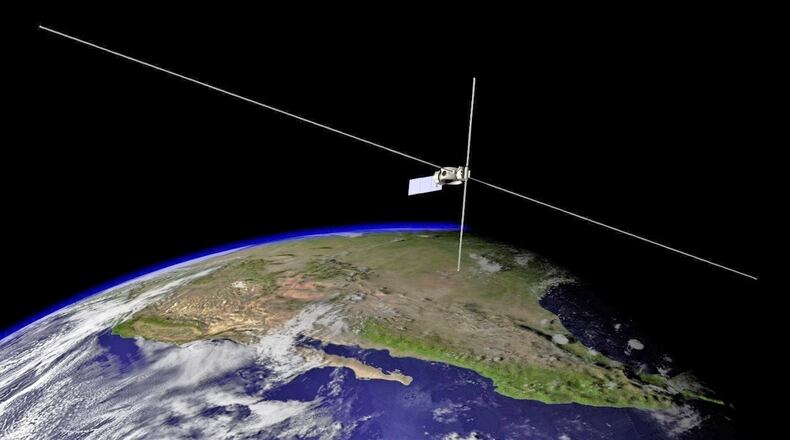“Most of the spacecraft developed at AFRL are primarily focused on technology development and demonstration,” said Dr. Robert Johnston, the team’s lead science investigator. “However, as its name indicates, DSX also built as a platform for science experiments.”
The satellite, which was roughly the size of a football field, consisted of four experiment suites designed to increase knowledge of conditions in the challenging orbital regime known as Medium Earth Orbit (MEO) and to test advanced spacecraft control techniques.
“MEO overlaps the Van Allen Radiation Belts, which are regions of charged particles trapped in the Earth’s magnetic field,” Johnston explained. “At their very high speeds, these particles pose a natural radiation hazard and their tendency to disturb and degrade spacecraft electronics means the region is challenging for spacecraft to use. Because the radiation belts are prone to frequent changes in MEO, we saw a promising opportunity to obtain a better understanding of those charged particles and their behavior.”
The first of DSX’s four experiment suites was known as the Wave Particle Interaction Experiment, which was designed to increase our understanding of the interaction between Very-Low Frequency (VLF) radio waves and the charged particles within the Van Allen Belts. Scientists have observed fluctuations in the radiation belts due to natural VLF waves generated from lightning.
“To learn more about this interaction, it made sense to insert a VLF antenna within the Van Allen Belts to create those radio waves and study their effect on the trapped particles,” said Johnston. “However, VLF waves are best created by a large antenna, so we equipped DSX with a lengthy boom for the VLF-emitting antenna.”
The first experiment focused on understanding the unique particle behavior, essential in developing technologies for Radiation Belt Remediation.
“In the event of a high-altitude nuclear explosion, an artificial radiation belt can be created, potentially affecting the more popularly utilized Low Earth Orbit with radiation far more intense than the natural radiation belts,” said Dr. Michael Starks the AFRL lead for radiation belt remediation. “The effects could be extremely detrimental to many of the space-based services our nation and the world rely on, so a capability to remediate, or clear out, those particles is invaluable.”
Another DSX experiment suite was the Space Weather Experiment, to study the locations and intensities of the various kinds of particles trapped within the Van Allen Belts.
“The Space Weather Experiment supported the Wave Particle Interaction Experiment in detecting the VLF-induced behavior of those particles—together, the two experiments will allow scientists to have greater understanding of how the Van Allen Belts change,” said Johnston. “We also collected data to supplement computer models of the region that will enable engineers to improve how they design satellites for this harsh radiation environment.”
The third experiment hosted on DSX was the Space Effects Experiment. This experiment was in partnership with the National Aeronautics and Space Administration and measured the degradation of commonly used spacecraft components in the harsh MEO environment over the course of the mission. This data will be applied to better equip spacecraft to operate in MEO.
The last of the DSX experiment suites is the Adaptive Controls Experiment, designed to gain a greater understanding of how to maneuver a large orbiting structure, which will benefit future large AFRL flight experiments.
“DSX is the largest unmanned self-supporting structure ever put into orbit,” said Johnston. “This made it well suited for the Adaptive Controls Experiment, which demonstrated on-board control of the vibrations that result from changing the orientation of a large structure.”
After spending nearly 2 years on orbit, DSX was intentionally passivated May 31, 2021, concluding all mission operations.
“AFRL engineers and scientists will be analyzing the remarkable amount of data collected from the experiment for many years to come,” said Johnston. “We completed more than 1,300 experiments, and the valuable lessons learned and technologies proven by DSX, will continue to affect the design of future AFRL spacecraft well into the future.”
About the Author
